Kneading is an essential step in making quality bread. But how do you ensure your kneading is successful?
We explore the key elements of foolproof bakery dough.
The key ingredients of dough
#1: Flour
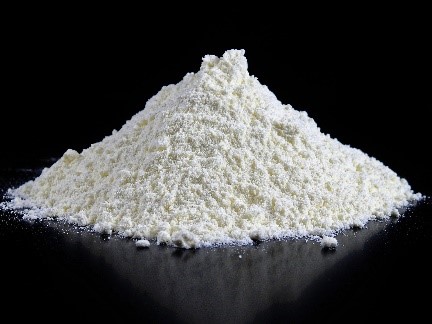
Flour is the primary ingredient of all doughs. It has two essential components, starch and gluten. Starch is the main element and makes up 60 to 72% of flour. Gluten forms and grows by absorbing water.
It provides elasticity, tenacity, cohesion, tightness, and gas retention to power the dough.
There is a wide variety of flour. The most commonly used are:
- Strong flour: made from exotic wheat. It has a reasonably low extraction rate, and it contains a higher amount of gluten. The quality and quantity of gluten determine the strength of the flour. Strong flour is recommended for making bread to give elasticity and volume. Basically, it provides excess power for the dough. That’s why it’s often mixed with all-purpose flour, which has a lower gluten content.
- Whole grain flour: contains all the elements of the wheat grain.
- Rye flour: after wheat, rye is the most widely used flour. The difference between these two flours is the proteins that come from them. When rye flour is hydrated, it does not form gluten, unlike the proteins in wheat flour. Rye is often mixed with gluten-rich-flour to hep the dough rise.
- Gluten-free flours are becoming more and more trendy, but they are not used in the same way as classic gluten-based flours. They have very different textures, properties, and tastes. That’s why it’s a good idea to combine them to find flavors and consistencies to elevate your recipes.
#2: Water
Water is another essential element in bread dough. It represents between 55 and 80% of the recipe. Its role is to obtain the desired texture and create the ideal environment for yeast or sourdough. To get a dough at the ideal temperature of 25°C/77°F, water should be at room temperature, like the flour and the bowl where the ingredients will be mixed.
#3: Ferments
There are two types of ferment: commercial yeast and sourdough or “levain”, also known as leaven.
They are essential in bread dough since they allow it to rise. They are also fragile. They are living organisms sensitive to extreme temperatures and high amounts of sugar or salt.
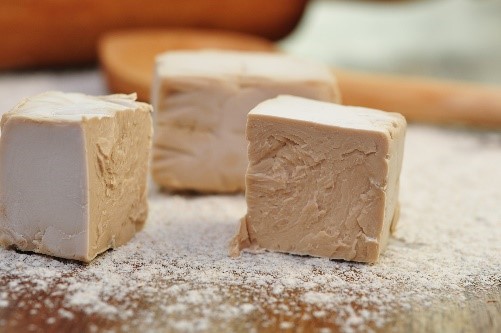
- Commercial yeast
Yeast feeds on sugar. It can transform the sugars naturally present in the flour into carbon dioxide and alcohol. This is called “alcoholic fermentation”. Thanks to its carbon dioxide production, it ensures the leavening of the dough, which means the dough rises and aerates, causing the lightness and honeycomb effect of bread. The production of alcohol as part of the fermentation process also contributes to the flavor of your bread.
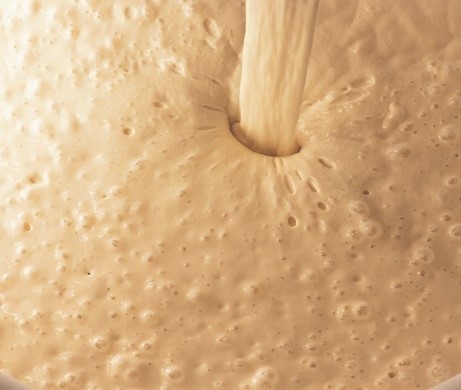
- Levain
Levain sourdough grows in a starter of flour and water and captures micro-organisms in the natural environment. The yeast and bacteria multiply to make the dough work through natural fermentation.
This ferment has a more pronounced taste than yeast-based bread and also creates a more digestible and healthier bread.
#4 : Salt
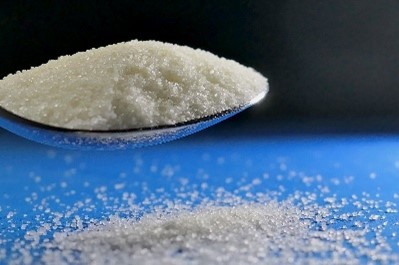
The salt improves the malleable qualities of the dough, increasing its toughness, elasticity, and workability.
Why is kneading important?
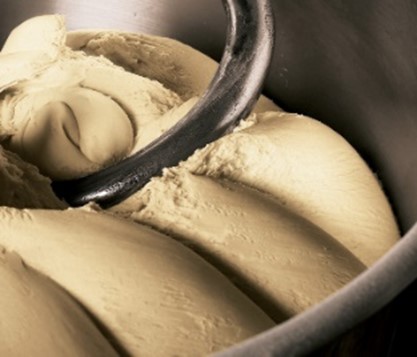
The kneading phase of a dough mixer comprises two main steps: premixing and stretching. To get a structured, smooth and homogeneous dough, the mixer arm must make a regular movement in the bowl, characterized by successive pressure, stretching, and shearing.
Kneading aims to make the gluten absorb as much water as possible to create volume and structure in the dough. Around 72% of flour is starch, which will soak up about 1/3 of its weight in water. Gluten represents 12% of the flour and will absorb 2 to 3 times its weight in water. So first the starch absorbs as much water as it can, and then the gluten integrates the remaining moisture.
The amount of water absorbed by the gluten determines the firmness of the dough. The less water the gluten absorbs, the more compact it is and the firmer the dough is. And the more water the gluten absorbs, the more your dough will be soft and stretchy.
Step 1: Premixing
Premixing means combining all the ingredients that make up the dough. Successful premixing is essential to making bread, as a dough that is well combined will produce higher quality bread.
This mixing process, also called autolyse, should be done slowly, with a kneading machine or a mixer, for a few minutes. When the ingredients are properly combined, the starch and gluten will be able to absorb the water in the recipe.
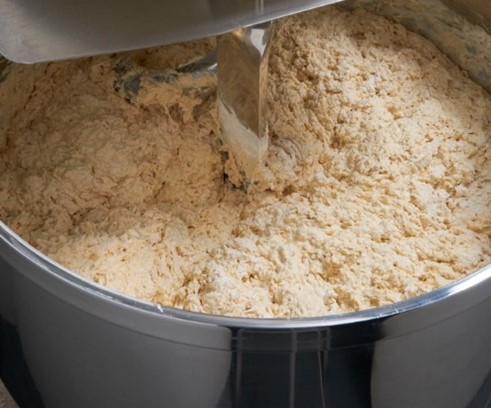
The gluten combined with water will swell during this stage and become sticky to form a glutinous network, a mesh structure.
The gluten proteins created will then coat the starch particles evenly.
You can add either water or flour during this phase to modify the consistency you want for your dough.
Step 2: Stretching
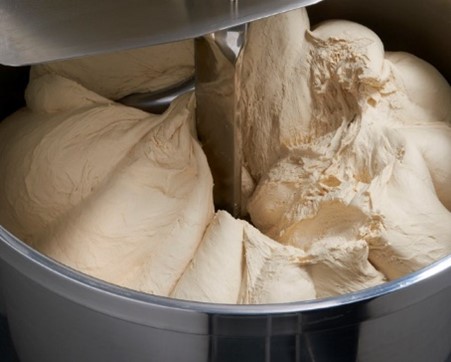
Stretching is also known as blowing. It is carried out at a faster speed than premixing. The duration of the stretching process varies according to your kneading equipment (shape of the tool, power, etc.). Average times are:
- 3 to 5 minutes for a double spiral mixer.
- 5 to 8 minutes for a spiral mixer.
- 6 to 10 minutes for a fork mixer.
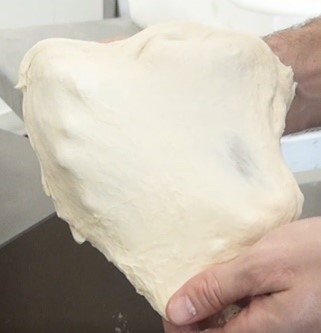
During the stretching process, the gluten will stretch and soften, more or less depending on its quality. Air is also added to the dough in large quantities and will make up about 20% of the volume of the final dough. At the end of the stretching process, the dough should be homogeneous and flexible. The baker takes a dough sample from the vat to stretch it manually and check its flexibility and elasticity.
How do I know when the kneading is finished?
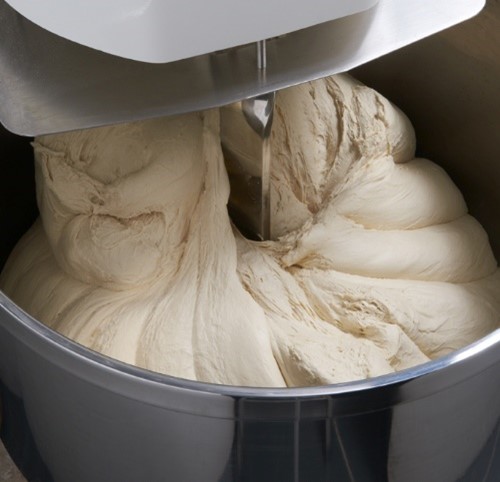
The duration of the kneading process varies depending on the baker’s method of working, the equipment, the amount of dough in the professional mixer, and the characteristics of the chosen flour. The kneading is finished when the dough does not stick to the wall of the bowl at all, and is elastic and stretchy, and dry to the touch.
How to achieve a “good ” dough
A successful dough should not be sticky. It should be soft, have a good hold, and have “body”. Bodymeans that when the dough is stretched it is elastic and responsive. It should be very workable but have a slight resistance when handled.
What to avoid during kneading
Here are some signs that the kneading hasn’t worked and you may need to revisit your recipe or process :
- Loose dough has an oozing surface, returns water, and is often sticky. The bread will be flat and crumbly when it comes out of the oven.
- Smooth dough: the surface appears oily, sticks, and the bread turns red in the oven.
- Dough with too much strength: it tears, stretches easily, and the bread is round and lacks aeration.
- Short dough: it lacks “body,” suppleness, and elasticity; it tears. During fermentation,
it grows “round” and cracks on the surface.
For a successful breadmaking, it is essential to understand the different ingredients of the dough, how they function and interact. The premixing and stretching phase are critical to the dough’s quality, as are the quality of the ingredients and the equipment you use !
